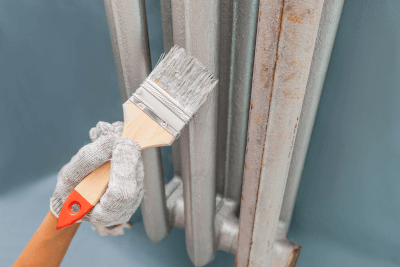What Is a Heat Resistant Coating?

Heat-resistant coatings are paints that resist heat.
Heat-resistant coatings have a temperature resistance of 100°C or higher, whereas general paints have a temperature resistance of 70°C to 100°C. The resin used in general paints differs from that used in heat-resistant paints. Heat-resistant coatings are made of silicone resin, which does not decompose easily when heated.
In addition, “body pigments” are added to increase the strength of the paint film, and the heat resistance temperature differs depending on the type of pigment.
Applications for Heat Resistant Coatings
Heat-resistant coatings can be used in temperatures from about -50°C to about 600°C. They are both cold and heat-resistant. Therefore, they can be used primarily in areas exposed to high temperatures. Familiar examples include coatings on stoves, camping equipment, pots and pans, motorcycle mufflers, incinerators, and boilers.
In addition to being resistant to heat, they can also be used in changing climates. However, since heat-resistant temperatures vary depending on the pigment used, it is necessary to check the temperature of the area where the paint will be used and select the right paint for the application.
Principle of Heat Resistant Coatings
Heat-resistant coatings are made from a silicone resin base, containing body pigments to increase strength, anti-corrosion pigments, color pigments, solvents, additives, and other materials. Each of the raw materials in heat-resistant coatings is heat resistant. Resins are the backbone components related to the performance of the paint.
Color pigments are used as reinforcing materials to prevent rust. Additives support the heat-resistant raw materials and stabilize the paint film. Solvents are necessary for clay conditioning. They enhance the fluidity of the ingredients and improve the workability of the paint.
The process of applying heat-resistant coatings is almost the same as for general paints. To ensure that the paint adheres to the material before coating, a surface preparation called “kerene” is important. If heat-resistant coatings are applied without surface preparation, the paint will not adhere to the material and will easily peel off.
Baking drying at 200°C for approximately one hour is required. Parts with heat-resistant coatings are forced-dried using electric heaters, burners, or drying ovens. However, rapid heating may cause the paint film to react and produce large amounts of gas.
Types of Heat Resistant Coatings
Like other paints, there are several types of heat-resistant paints, such as brush-on, spray, and marker-pen types. The brush type is suitable for painting large objects over a wide area, such as boilers and incinerators in factories. The spray type is suitable for curved surfaces and intricate parts such as motorcycle mufflers. Markers can be used for small areas, such as marking areas that are subject to high heat in laboratories, factories, and other production sites.
Depending on the pigments and additives mixed in addition to the different types of application methods, there are also products with additional performance characteristics such as water resistance, acid resistance, and rust resistance. Rust-resistant paints are used in outdoor facilities, while acid-resistant paints are used to protect the interior of plant equipment from combustion gases and other acids and heat.
Generally, silicone resins are available for heat-resistant coatings. Fluoropolymers are mainly used for frying pans, hot plates, and other cooking utensils, as they must be made of ingredients that are not harmful to the human mouth.
How to Select Heat Resistant Coatings
A wide variety of heat-resistant coatings are available and can be selected according to the intended use. Heat-resistant coatings are available in a wide variety of colors and can be selected to match the color of the area to be painted to achieve a natural look. It also has the effect of preventing discoloration due to deterioration. The appearance changes depending on the luster, which can be selected based on the gloss of the heat-resistant coatings.
For painting over a large area, a large-volume type painted with a brush is suitable. In many cases, applications are listed, such as for motorcycles or cast iron stoves.
In addition to products with heat resistance temperatures from 300°C to 600°C, some are designed for commercial applications with heat resistance temperatures of 1,000°C or 2,000°C. Some types have improved corrosion resistance, durability, and adhesion when coated with a special primer, and their performance varies with heat-resistant coatings. Drying time after painting also varies, so it is necessary to check the drying time along with the performance.